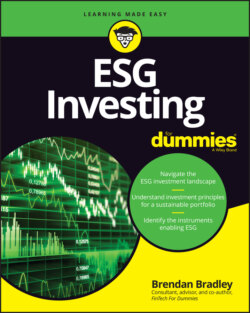Читать книгу ESG Investing For Dummies - Brendan Bradley - Страница 66
Live and let live: Biodiversity
ОглавлениеThe effects of human action on the natural world are deeply harmful, and as our population increases and the search for economic growth continues, the threat will only increase. Damage to ecosystems across the world, and the resulting loss of biodiversity, has collected fewer headlines than other sustainability challenges, even though the biodiversity crisis is a direct risk to humankind.
Part of the problem is that it’s difficult to quantify due to the heterogeneity of ecosystems, making the correct response difficult to identify. Clearly, biodiversity loss is directly related to the climate emergency, and more companies, governments, and the public are recognizing this. For example, the protection of the ecosystems found in natural forests is a key solution to mitigating global warming. Extinction rates are multiple times higher than the historic rate, and approximately 1 million species are at threat out of a total of 8 million plant and animal species on earth. However, companies have consistently struggled to evaluate how their activities affect biodiversity, partly due to the exceptional complexity of the living systems that their value chains interact with.
Investments in biodiversity contribute directly to the full range of UN Sustainable Development Goals (SDGs). Conserving biodiversity and ecosystems preserves the ability of our planet to sustain our prosperity. Biodiversity finance combines conventional capital with financial incentives to fund sustainable biodiversity management. It can include private and public financial resources, and investments in commercial businesses that create positive biodiversity outcomes. However, most funding originates from public funds, including domestic public budgets, biodiversity-positive agricultural subsidies, and international transfers of public funds, and these activities haven’t been well communicated on a national scale. Moreover, without specific information on recipient-country expenditures and priorities, development partners have been unwilling to promise support to reach biodiversity management goals and objectives. Investors tend to lump the associated risks in with industries such as mining.
Therefore, investors are demanding more information on biodiversity to ensure any risks are well managed. Meanwhile, increasing awareness that assets can become stranded through biodiversity loss is escalating the response. For example, biodiversity issues on agricultural land diminish its capacity to grow crops and can lead to the land becoming stranded. Financial organizations need to support the growth of methodologies to gauge biodiversity loss, conservation, and enhancement. More data is required to quantify biodiversity risks to enable integration into valuation tools. Investors should allocate assets toward companies that work in environmentally sustainable ways and create biodiversity-positive technologies while embedding biodiversity protection. And companies need to further disclose the impact of their economic activities on biodiversity.
Some tools are currently being developed that compare how companies respond to material biodiversity risk, which should help investors understand how companies are mitigating “known unknown” risks, as well as compare how they balance economic returns with sustainable benefits. Many hope that such indicators will realize for biodiversity loss what the tools highlighting CO2 emission levels achieved for climate change (I cover CO2 earlier in this chapter). These indicators will need to identify any correlation between biodiversity and the success of the economy and allow investors to place an economic value on biodiversity.
The COVID-19 pandemic should accelerate the focus on sustainable investing in general and biodiversity more specifically. Still, the pandemic shows that when biodiversity is destroyed, the system that supports human life is also affected, as the loss of biodiversity provides an opportunity for pathogens to pass between animals and people more freely. However, the risk is that policymakers and companies spend too much time focused on the fallout from the pandemic, including increasing debts, balance sheet damage, and weaker profits, such that other biodiversity issues remain in the background.
